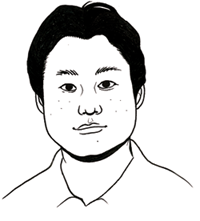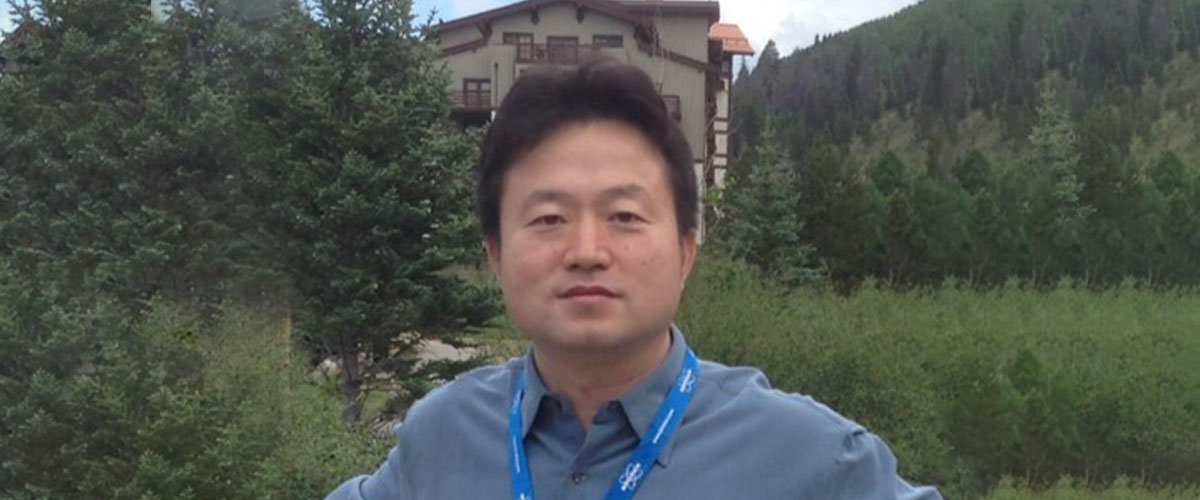Dr. Likai Song is a physicist as well as a medical doctor who aptly describes himself as a biophysicist, i.e., a scientist who uses methods of physics to discover how biological systems work.
He was born in China and grew up in Beijing. He received his training in internal medicine and cardiology at the Beijing 301 Hospital and studied biophysics at Florida State University. After completing his doctorate at FSU in 2005, he worked as a research scientist at the Dana Farber Cancer Institute, an affiliate of the Harvard Medical School, in Boston. In 2010, he and his wife and daughter moved back to Florida.

MagLab scientist Likai Song
It was the magnets that drew him to Tallahassee. At the Boston cancer center, he’d begun collaboratively working with a pioneering group of doctors and researchers whose goal is to develop a vaccine for HIV (Human Immunodeficiency Virus). HIV infects the cells of a person’s immune system and destroys or impairs their function. According to World Health Organization estimates, more than 35 million people were living with HIV at the end of 2012. That same year, about 2.3 million people also became newly infected and 1.6 million died of AIDS-related causes.
In order to create a vaccine or drug for this virus, Dr. Song uses the lab’s magnets to probe a surface protein of the HIV virus called “gp41.” His studies focus on how the virus, with the help of this protein, enters through a healthy cell’s membrane to infect it. His goal is to learn how to prevent an HIV infection by targeting the gp41 protein using a vaccine or drug.
Since moving to Tallahassee, Dr. Song and his wife have also had another daughter.
How do you describe your work?
“As a biophysicist, I work in an interdisciplinary area that allows me to use both my knowledge of physics and biology. I use physical tools like EPR (Electron Paramagnetic Resonance) to study the structure of molecules in the human body. “The basic nature of science is solving problems, so as a scientist, I am a problem solver. Some days, you have to figure out if you prepared your sample correctly, or if the machine is behaving as it should. That’s not unusual.”
Did you always want to be a doctor?
“I didn’t actually know what I wanted to do when I was kid — but I knew what I was interested in. In high school, I was really good at math and physics, and I was also exposed to some very good Chinese role models who were physicists. So I always knew I was interested in physics and science, but also in biology and medicine.”
When he went to college though, he had to decide on a direction. He chose medicine.
How did you make the jump from medicine to physics?
“People always ask me that question! People don’t understand how I can make such a jump, and I know it does seem like a big jump from there to what I do now. But actually for me, it seems all-natural, because I was always interested in both. Even after I finished my medical degree and I became a doctor, I still had that interest in basic science such as biology and physics. Being a biophysicist to solve biomedical problems seems to be a good fit for me.
“As a doctor, to treat diseases, you do that in a clinic. You see actual patients, and you help individuals. But if you really want to cure a disease that affects many people, then you have to do basic research.”
What happened to bring you to the MagLab?
“In Boston, at Harvard, I developed my interests and my projects in HIV research. What I was using to do my research, my main tool and method of inquiry, is actually EPR (Electron Paramagnetic Resonance). And the EPR facility in Boston is not comparable to the EPR facility here at the MagLab. This is the best place. We have world-class magnets and instruments at the Maglab. This year, we built a new EPR machine, the HiPER machine, a powerful instrument that will benefit my research and the research of scientists who visit the lab.”
What kind of research are you doing?
“I am interested in using EPR and other methods to study the structure and functions of proteins in the human body. This area of research is also called structural biology. Structural biology captures the images of life at molecular and atomic levels. Structural biologists use various physical tools to determine the molecular details of proteins and DNAs, such as x-ray, magnetic resonance, electron microscopy, etc.
“One of my current projects is to determine the structure and role of an HIV surface protein, gp41, in virus infection. It has been widely accepted that HIV viruses enter into human T cells (white blood cells that play various important roles in the human immune system) via cell-to-cell membrane fusion. Gp41 plays a key role during this process. Interestingly, anti- HIV antibodies can inhibit gp41 function, and thereby prevent HIV infection. A better understanding of gp41 function, and how antibodies disrupt its function, would help scientists to design a vaccine or treatment for HIV.”
Can you explain your group’s approach to creating an HIV vaccine?
“Scientists have been trying to make an HIV vaccine for the last 20 to 30 years, and they’ve tried all kinds of different methods, including using HIV proteins, peptides, genes, etc. So far, no successful vaccine strategy has been found.
“I am working on a collaborative project, along with several other research groups within the U.S. My collaborators include immunologists, clinicians and structural biologists with a common goal to study the structural details of HIV surface protein gp41, and develop a vaccine based on the structural information. My group is using EPR to study the structure of gp41 sitting on the viral membrane surface, and how anti-HIV antibodies interact with gp41, inhibit gp41 function and prevent virus infection.”
As with other vaccines, Dr. Song’s group is creating a vaccine that “mimics part of the virus or bacteria so that the human immune system can recognize the vaccine and develop some antibodies against it. Hopefully, those generated antibodies can also cure the virus.
“We are trying to study the basic structure of the surface protein of HIV, and then develop an optimized immune agent so the human body recognizes it as a native HIV virus and develops antibodies to cure HIV.”
How close are you to creating an HIV vaccine?
“We’re in the middle of the journey, I would say, because some of our results are very promising. A study published in the New England Journal of Medicine in 2012 also showed some promising data of clinical trials conducted in Thailand. But it is still a long way to go to develop a safe and effective vaccine. I think we are getting closer and closer.”
Do you have any advice for young people who are still trying to determine their future careers?
“Follow your true interests and try to find out what you are really good at. Then use this information to decide your path.”
This story was originally published in Issue 10 of flux magazine, a discontinued publication of the National High Magnetic Field Laboratory.
By Kathleen Laufenberg



